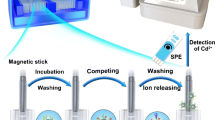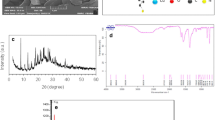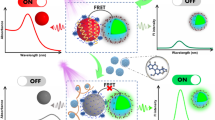Abstract
In this study, we designed a ZnCdS@ZnS quantum dots (QDs)–based label-free electrochemiluminescence (ECL) immunosensor for sensitive determination of aflatoxin B1 (AFB1). A Nafion solution assembled abundant QDs on the surface of a Au electrode as ECL signal probes, with specially coupled anti-AFB1 antibodies as the capturing element. As the reduction reaction between S2O82− in the electrolyte and QDs on the electrode led to ECL emission, the decreased ECL signals resulting from target AFB1 in the samples were recorded for quantification. We evaluated electrochemical impedance spectroscopy and ECL measurements along each step in the construction of the proposed immunosensor. After systematic optimization of crucial parameters, the ECL immunosensor exhibited a good sensitivity, with a low detection limit of 0.01 ng/mL for AFB1 in a wide concentration range of 0.05–100 ng/mL. Testing with lotus seed samples confirmed the satisfactory selectivity, stability, and reproducibility of the developed ECL immunosensor for rapid, efficient, and sensitive detection of AFB1 at trace levels in complex matrices. This study provides a powerful and universal analytical platform for a variety of analytes that can be used in broad applications for real-time analysis, such as food and traditional Chinese medicine safety testing, environmental pollution monitoring, and disease diagnostics.

Development of a ZnCdS@ZnS quantum dots based label-free electrochemiluminescence immunosensor for sensitive detection of aflatoxin B1 in lotus seed.






Similar content being viewed by others
References
Ashiq S, Hussain M, Ahmad B (2014) Natural occurrence of mycotoxins in medicinal plants: a review. Fungal Genet Biol 66:1–10
Carballo D, Tolosa J, Ferrer E, Berrada H (2019) Dietary exposure assessment to mycotoxins through total diet studies: a review. Food Chem Toxicol 128:8–20
Matejova I, Svobodova Z, Vakula J, Mares J, Modra H (2017) Impact of mycotoxins on aquaculture fish species: a review. J World Aquacult Soc 48:186–200
Dai YQ, Huang KL, Zhang BY, Zhu LY, Xu WT (2017) Aflatoxin B1-induced epigenetic alterations: An overview. Food Chem Toxicol 109:683–689
Zhang BY, Huang KL, Zhu LY, Luo YB, Xu WT (2017) Precision toxicology based on single cell sequencing: an evolving trend in toxicological evaluations and mechanism exploration. Arch Toxicol 91:2539–2549
Yang X, Lv YJ, Huang KL, Luo YB, Xu WT (2016) Zinc inhibits aflatoxin B1-induced cytotoxicity and genotoxicity in human hepatocytes (HepG2 cells). Food Chem Toxicol 92:17–25
World Health Organization [WHO] and International Agency for Research on Cancer [IARC] (1993) Some naturally occurring substances: food items and constituents, heterocylic aromatic amines and mycotoxins. IARC Monogr Eval Carcinog Risks Hum 56:599
Anfossi L, Giovannoli C, Baggiani C (2016) Mycotoxin detection. Curr Opin Biotechnol 37:120–126
Cho HD, Suh JH, Feng S, Eom T, Kim J, Hyun SM, Kim J, Wang Y, Han SB (2019) Comprehensive analysis of multi-class mycotoxins in twenty different species of functional and medicinal herbs using liquid chromatography- tandem mass spectrometry. Food Control 96:517–526
Toman J, Ostry V, Grosse Y, Roubal T, Malir F (2018) Occurrence of ochratoxin A in Astragalus propinquus root and its transfer to decoction. Mycotoxin Res 34:223–227
European Commission (2010) Commission Regulation (EC) No 165/2010 of 26 February 2010 amending regulation (EC) no. 1881/2006 setting maximum levels for certain contaminants in foodstuffs as regards aflatoxins. Off J Eur Union 38:8–10
Chinese Pharmacopoeia Commission (2015) Chinese pharmacopoeia of the People’s Republic of China, vol 4. Chinese Medicine Science and Technology Press, Bejing
Hamed AM, Moreno-González D, García-Campaña AM, Gámiz-Gracia L (2017) Determination of aflatoxins in yogurt by dispersive liquid-liquid microextraction and HPLC with photo-induced fluorescence detection. Food Anal Methods 10:516–521
Wei F, Liu XF, Liao XF, Shi LC, Zhang SW, Lu JH, Zhou LD, Kong WJ (2019) Simultaneous determination of 19 mycotoxins in lotus seed using a multimycotoxin UFLC-MS/MS method. J Pharm Pharmacol 71:1172–1183
Yang Y, Li GL, Wu D, Liu J, Li XT, Luo PJ, Hu N, Wang HL, Wu YN (2020) Recent advances on toxicity and determination methods of mycotoxins in foodstuffs. Trends Food Sci Technol 96:233–252
Tang DP, Lin YX, Zhou Q (2018) Carbon dots prepared from Litchi chinensis and modified with manganese dioxide nanosheets for use in a competitive fluorometric immunoassay for aflatoxin B1. Microchim Acta 185:476
Mahmoudpour M, Dolatabadi JEN, Torbati M, Tazehkand AP, Homayouni-Rad A, de la Guardia M (2019) Nanomaterials and new biorecognition molecules based surface plasmon resonance biosensors for mycotoxin detection. Biosens Bioelectron 143:111603
Zhou Q, Tang DP (2020) Recent advances in photoelectrochemical biosensors for analysis of mycotoxins in food. Trends Anal Chem 124:115814
Sun CN, Liao XF, Huang PX, Shan GZ, Ma X, Fu LZ, Zhou LD, Kong WJ (2020) A self-assembled electrochemical immunosensor for ultra-sensitive detection of ochratoxin A in medicinal and edible malt. Food Chem 315:126289
Shao XL, Zhu LJ, Feng YX, Zhang YZ, Luo YB, Huang KL, Xu WT (2019) Detachable nanoladders: a new method for signal identification and their application in the detection of ochratoxin A (OTA). Anal Chim Acta 1087:113–120
Zhu LJ, Shao XL, Luo YB, Huang KL, Xu WT (2017) Two-way gold nanoparticle label-free sensing of specific sequence and small molecule targets using switchable concatemers. ACS Chem Biol 12:1373–1380
Wang HJ, Yuan YL, Zhuo Y, Chai YQ, Yuan R (2016) Sensitive electrochemiluminescence immunosensor for detection of N-acetyl-β-d-glucosaminidase based on a “light-switch” molecule combined with DNA dendrimer. Anal Chem 88:5797–5803
Wang YG, Zhao GH, Li XJ, Liu L, Cao W, Wei Q (2018) Electrochemiluminescent competitive immunosensor based on polyethyleneimine capped SiO2 nanomaterials as labels to release Ru(bpy)32+ fixed in 3D Cu/Ni oxalate for the detection of aflatoxin B1. Biosens Bioelectron 101:290–296
Zhang HY, Miller BL (2019) Immunosensor-based label-free and multiplex detection of influenza viruses: state of the art. Biosens Bioelectron 141:111476
Yan Q, Cao LL, Dong H, Tan ZL, Hu YT, Liu Q, Liu H, Zhao PP, Chen L, Liu YY, Li YY, Dong YH (2019) Label-free immunosensors based on a novel multi-amplification signal strategy of TiO2-NGO/Au@Pd hetero- nanostructures. Biosens Bioelectron 127:174–180
Wang Q, Wang XD, Xu M, Lou XD, Xia F (2019) One-dimensional and two-dimensional nanomaterials for the detection of multiple biomolecules. Chin Chem Lett 30:1557–1564
Goud KY, Reddy KK, Satyanarayana M, Kummari S, Gobi VK (2020) A review on recent developments in optical and electrochemical aptamer-based assays for mycotoxins using advanced nanomaterials. Microchim Acta 187:29
Zhang K, Lv S, Lin ZZ, Tang DP (2017) CdS: Mn quantum dot-functionalized g-C3N4 nanohybrids as signal-generation tags for photoelectrochemical immunoassay of prostate specific antigen coupling DNAzyme concatamer with enzymatic biocatalytic precipitation. Biosens Bioelectron 95:34–40
Yang X, Yu YQ, Peng LZ, Lei YM, Chai YQ, Yuan R, Zhuo Y (2018) Strong electrochemiluminescence from MOF accelerator enriched quantum dots for enhanced sensing of trace cTnI. Anal Chem 90:3995–4002
Lin YX, Zhou Q, Tang DP, Niessner R, Yang HH, Knopp D (2016) Silver nanolabels-assisted ion-exchange reaction with CdTe quantum dots mediated exciton trapping for signal-on photoelectrochemical immunoassay of mycotoxins. Anal Chem 88:7858–7866
Li DY, Bai JK, Zhang TT, Chang C, Jin X, Huang Z, Xu B, Li QH (2019) Blue quantum dot light-emitting diodes with high luminance by improving the charge transfer balance. Chem Commun 55:3501–3504
Jain S, Bharti S, Bhullar GK, Tripathi SK (2020) I-III-VI core/shell QDs: synthesis, characterizations and applications. J Lumin 219:116912
Ding SN, Jin Y, Chen X, Bao N (2015) Tunable electrochemiluminescence of CdSe@ZnSe quantum dots by adjusting ZnSe shell thickness. Electrochem Commun 55:30–33
Zeiri N, Naifar A, Abdi-Ben Nasrallah S, Said M (2019) Quadratic optical effects in ZnS/CdS/ZnS quantum dot-quantum well. Results Phys 14:102513
Gerhardt GA, Oke AF, Nagy G, Moghaddam B, Adams RN (1984) Nafion-coated electrodes with high selectivity for CNS electrochemistry. Brain Res 290:390–395
Guo JX, Lee JG, Tan T, Yeo J, Wong PW, Ghaffour N, An AK (2019) Enhanced ammonia recovery from wastewater by Nafion membrane with highly porous honeycomb nanostructure and its mechanism in membrane distillation. J Membr Sci 590:117265
Hosseini M, Pur MRK, Norouzi P, Moghaddam MR, Ganjali MR (2017) An enhanced electrochemiluminescence sensor modified with a Ru(bpy)32+/Yb2O3 nanoparticle/nafion composite for the analysis of methadone samples. Mater Sci Eng C 76:483–489
Sharma A, Kumar A, Khan R (2018) A highly sensitive amperometric immunosensor probe based on gold nanoparticle functionalized poly(3, 4-ethylenedioxythiophene) doped with graphene oxide for efficient detection of aflatoxin B1. Synth Met 235:136–144
Yu LL, Zhang Y, Hu CY, Wu H, Yang YY, Huang CS, Jia NQ (2015) Highly sensitive electrochemical impedance spectroscopy immunosensor for the detection of AFB1 in olive oil. Food Chem 176:22–26
Lai WQ, Wei QH, Xu MD, Zhuang JY, Tang DP (2017) Enzyme-controlled dissolution of MnO2 nanoflakes with enzyme cascade amplification for colorimetric immunoassay. Biosens Bioelectron 89:645–651
Su LS, Tong PT, Zhang LJ, Luo ZB, Fu CL, Tang DP (2019) Photoelectrochemical immunoassay of aflatoxin B1 in foodstuff based on amorphous TiO2 and CsPbBr3 perovskite nanocrystals. Analyst 144:4880–4886
Funding
This study is support from the National Natural Science Foundation of China (81673593 and 81973474), CAMS Innovation Fund for Medical Sciences (2016-I2M-3-010), and Beijing Natural Science Foundation (7192130).
Author information
Authors and Affiliations
Corresponding authors
Ethics declarations
Conflict of interest
The author(s) declare that they have no competing interests.
Additional information
Publisher’s note
Springer Nature remains neutral with regard to jurisdictional claims in published maps and institutional affiliations.
Rights and permissions
About this article
Cite this article
Sun, C., Liao, X., Jia, B. et al. Development of a ZnCdS@ZnS quantum dots–based label-free electrochemiluminescence immunosensor for sensitive determination of aflatoxin B1 in lotus seed. Microchim Acta 187, 236 (2020). https://doi.org/10.1007/s00604-020-4179-x
Received:
Accepted:
Published:
DOI: https://doi.org/10.1007/s00604-020-4179-x




